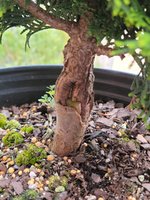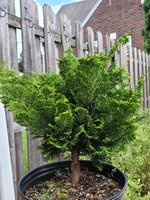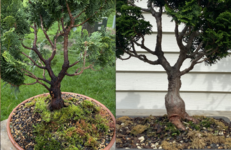QuantumSparky
Shohin
I just bought a small Hinoki Cypress from a nursery and noticed a small wedge-like thing stuck into the trunk right by an old scar from a removed branch perhaps. Does anyone know why there would be a wedge in there? I'm not sure if I should try to remove it or not.
As a side note, I'd love to hear any styling tips you guys have for this tree!


In this image, the tree is leaning directly away from the camera, I'm likely choosing that side as the front but I won't make the decision until I can do some more light pruning and take a better look at the interior branch structure. As for styling, this is my first nursery stock and there are a few really long branches that I'm not quite sure what to do with.
As a side note, I'd love to hear any styling tips you guys have for this tree!


In this image, the tree is leaning directly away from the camera, I'm likely choosing that side as the front but I won't make the decision until I can do some more light pruning and take a better look at the interior branch structure. As for styling, this is my first nursery stock and there are a few really long branches that I'm not quite sure what to do with.

